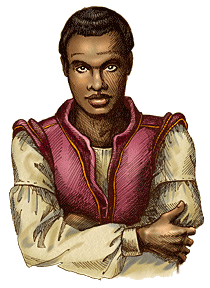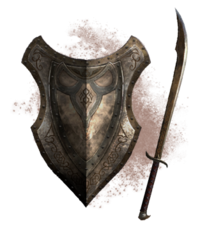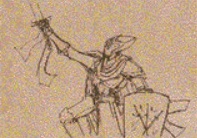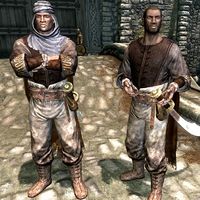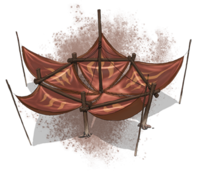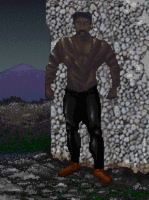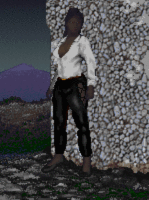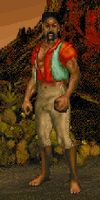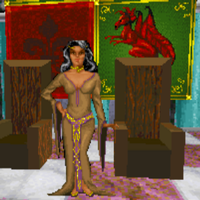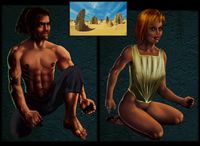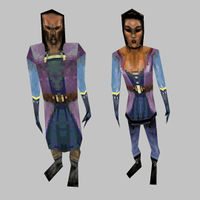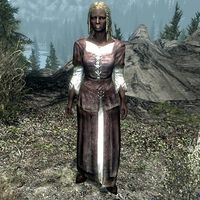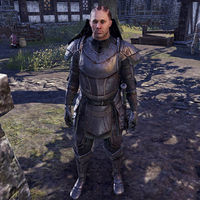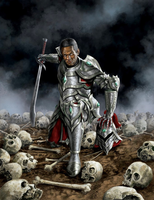User:MolagBallet/Sandbox 23
| This page or parts of this page were previously transcluded from lore pages per this discussion. This page should be checked for potential unrelated lore and other information. Please remove this banner when the page has been cleaned up. |
Redguards are the most naturally talented warriors in Tamriel. The dark-skinned, wiry-haired people of Hammerfell seem born to battle, though their pride and fierce independence of spirit makes them more suitable as scouts or skirmishers, or as free-ranging heroes and adventurers, than as rank-and-file soldiers.[1][2] In addition to their cultural affinities for many armor styles and weapons (particularly swords), Redguards are also physically blessed with hardy constitutions, resistance to poison, and quickness of foot. Unlike most other human races, they are not believed to have any connection with the ancestral Nordic homeland of Atmora.
Contraband[edit]
THIS SECTION EXISTS TO BE INCORPORATED INTO THE TEXT PROPER.
- Prayer Cloth of the Yokudan War-Gods - An ancient wall scroll studied by the Maidens of the Spirit Sword, somehow spirited away from the now-lost island nation.
- Supple Redguard Blade Polisher - An exquisitely worked strip of lion hide, treated with an oil of snake venom and ground beetle carapace. Worth every gold piece.
History[edit]
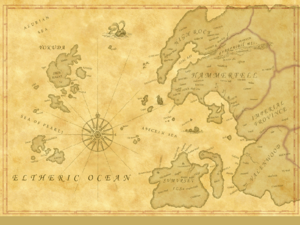
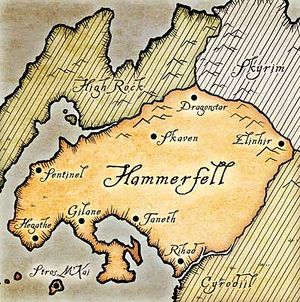
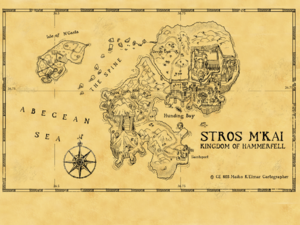
Redguards (formerly "Yokudans") hail from the western continent of Yokuda, which sank into the sea in ancient times. The cause of Yokuda's sinking is attributed either to natural factors (earthquakes, tsunamis, or volcanic eruptions) or to the revenge of a defeated band of Ansei called the Hiradirge. Upon the sinking of their homeland around 1E 792, the Yokudan fleet set sail to the east, eventually arriving in what would later be called Hammerfell.[3] The bulk of the refugees remained on the island of Herne while the Ra Gada, the Warrior Wave, continued on to mainland Hammerfell in 1E 808.[2][4]
Imperial scholars concluded that the term "Redguard" originated as a phonetic corruption of "Ra Gada".[2] However, Redguard myth considers it a legacy of the War of the Singers, a series of seven battles in Yokuda circa 1E 780, shortly before the continent was destroyed. Their legends say the war was fought between the army of the Last Emperor Hira and the greatly outnumbered Ansei (presumably the Hiradirge), who sought out the leadership of Lord Frandar Hunding at the onset. Hunding led the Ansei to victory using his "Hammer and the Anvil" strategy, but at great cost. Though they spared the land from Hira's tyranny, they had to leave it afterwards, for when Hunding's strategy reached fruition in the final battle (i.e., when the proverbial hammer fell), more than three hundred thousand people were killed. In the eyes of the citizenry, their guardians were red with blood. So they left Yokuda, sailing across the Eltheric Ocean, and took on new names to commemorate their final battle: their new land was Hammerfell, and their new name was the Redguards.[5][6] As Yokuda sank into the sea, the Yokudans were forced to follow them to this new land or perish.[3]
These were not the first Redguards to arrive in Tamriel, however. The Horsemen of the Rivenspire region of High Rock, long a myth, were confirmed to exist by scholars in the Second Era. They are believed to have migrated there from the Yokudan island of Akos Kasaz sometime in the early sixth century of the First Era.[7]
The Ra Gada Invasion[edit]
When they arrived, the Ra Gada attacked all settlements of Nede and Mer along with the native beasts, and conscripted those they did not slay as laborers or servants for the "warrior-sailors" of the Ra Gada.[8] After only a few brutal months, the Ra Gada had established a strong presence along the western shores of Hammerfell, disrupting and replacing the Imperial and Nordic raiders who had preyed upon the area for centuries.[9] From the footholds along the coast, they continued to launch assault after assault, eventually succeeding in driving off the Orcs and making way for the High King and the Yokudan royalty, known as the Na-Totambu, to safely arrive in Hammerfell.[10] All the old cities of the Dwemer in the region, with a few exceptions, are now the cities of today's modern Hammerfell.[11]
Despite how long ago they arrived, the Redguards are still the comparative newcomers: every other modern race had already emerged before the Ra Gada arrived at Tamriel's shores.[10] And despite the advanced culture they brought with them, their martial nature and the savagery with which they established themselves in Tamriel earned them a longstanding reputation as barbarians and cutthroats.[2]
The early Redguards faced a Goblin invasion, but drove them away. Later in the First Era, the Redguards came under threat from a second, seemingly unstoppable invasion of giant goblins. However, they were thwarted thanks to the leadership of Derik Hallin, who restored the teachings of Frandar Hunding and his Book of Circles, which have remained an integral part of Redguard life ever since.[11]
Foreign Relations[edit]
The Redguards scorned their neighbors initially, and didn't even trade with them until after their worth had been proven in the successful Siege of Orsinium circa 1E 980.[10][12] Their own native language, Yoku, was almost entirely replaced to help stabilize foreign trade,[2] although the language is still spoken.[13] They were absorbed into the Second Empire sometime during the Reman Dynasty.[2]
During the Alliance War circa 2E 582, they joined with the Orcs and Bretons in forming the Daggerfall Covenant. The strongest support for the Covenant centered in the city-states of Hallin's Stand and Sentinel, with much of the outer regions of Redguard society remaining distrustful of their new allies.[12]
Sometime during the Interregnum of the Second Era, the fragile administrative republic established in Hammerfell by the Second Empire collapsed, and control of the province reverted back to the traditional, hereditary monarchy of the Na-Totambu. The new High King of Hammerfell moved his seat of power from the old capital Hegathe to the more prosperous northern city of Sentinel. This ignited tension between Forebears and Crowns, as Sentinel was a Forebear city. Upon the death of High King Thassad II in 2E 862, the people of Sentinel retook their city by force. Crown Prince A'tor journeyed to the city to seek vengeance, leading to one of the bloodiest massacres in Tamrielic history.[2]
The bloody civil war which ensued led to Hammerfell being easily absorbed by the Septim Empire in 2E 864, though the Empire soon had to make some significant concessions of power following a successful revolt in Stros M'Kai.[10] Redguards would become more outgoing under the Septim Empire, and many branched out into other parts of Tamriel. Redguards reportedly served as mercenaries under the Camoran Usurper around 3E 267.[14]
King Camaron of Sentinel would be killed during the War of Betony in 3E 403, a short but vicious land dispute with Daggerfall over the eponymous island of Betony.[15] The aftermath brought a lot of bad blood between the Bretons and Redguards of the Iliac Bay region.[16][17] Following the Miracle of Peace, Sentinel (then under King Lhotun) greatly expanded to take over the entire northern coast of Hammerfell.[10][18] It's known that near the end of the Third Era, the Redguards of eastern Hammerfell harbored a fierce grudge against Skyrim, and yearned for a chance to take back land that was seized during the War of the Bend'r-mahk in 3E 396.[10][16]
Defiance in the Great War[edit]
In 4E 171, the Great War erupted when the Aldmeri Dominion demanded, in part, that the new Emperor Titus Mede II cede large tracts of southern Hammerfell to them. The Empire fought back, but ultimately made the concession as part of the White-Gold Concordat of 4E 175. Though the rest of the Empire left them to their fate, the Redguards refused to accept this and suffered mass devastation all over southern Hammerfell in their long, though successful, repulsion of the Dominion's invasion.[19] Many Redguards remain bitter over the Empire's abandonment and believe that their triumph is proof that the Concordat was a mistake, and the Empire would have succeeded had it fought on.[19][20]
Culture[edit]
Food[edit]
- Main Article: Redguard Cuisine
The Redguards live upon the arable land of the Alik'r, which makes farming an arduous task. They allow domesticated livestock (such as goats) to graze, and their crops need to be able to resist drought. They often dehydrate or salt their food for storage and trade. Everyday meals, on the other hand, are cooked using methods that don't exacerbate the intense heat of the sun during the day: flatbreads are baked within seconds on searing hot stones instead of ovens, and pots of stew are placed over coals to cook over long periods of time. Their port cities bring in trade that adds variety to their diet, and the hot peppers that grow in their homeland are prized both by them and cooks overseas.
Society[edit]
Like all races, Redguards have been shaped by their home. Since their arrival, they have been few in number, relative to the other races of Tamriel.[12] Their Yokudan heritage left them with advanced seafaring, agricultural, military and even astronomical knowledge that allowed them to thrive in a place where others merely hoped to survive. Redguard society is extremely martial, and nearly everyone is expected to have a grasp of basic weaponry and combat, although only the rulers are generally expected to have detailed knowledge of strategy, formations and tactics. Only the strongest, fastest and smartest Redguards are accepted into the demanding military (which consists mainly of various knightly orders; Redguards don't traditionally have a standing army), and they are expected to prove themselves worthy by facing death.[2] Even their entertainment, like snake charming, bears some risk to it.[21]
The practice of magic has generally been frowned upon dating back to the First Era,[22] and outsiders are not tolerated in many parts of Hammerfell.[2][12][23] Many believe that no "true" Redguard would stoop to using magic, considering it a weakness.[24] Certain schools that teach the Way of the Sword forbid students to use magic and enchanted weapons.[25] By the Third Era, spellcasters were shunned in Hammerfell, believing them to be wicked individuals who steal souls and tamper with minds.[26] Necromancy has always been abhorred in Redguard culture, due to their reverence of the dead. Although being suspicious of magic is regarded as a hallmark of Redguard culture, it was not always so pronounced. In ancient times, Yokudan war-wizards were part of their armies, albeit rare.[27] Sword-singers were said to have forged swords woven with magic and indeed the Shehai itself is believed to be a form of magic.[5]
They have a great affinity for horses, and brought many with them to Hammerfell, notably the breed called the Yokudan Charger.[7] The constellation of the Warrior and its charges seem to be of great importance in their ancient literature.[28][29]
Redguards have a great diversity in styles for their clothing,[2] though it always tends to be light, long, and flowing to best tolerate the heat and hazards of the desert. They first developed this style of dress in Yokuda, which was known to have arid deserts similar to the Alik'r desert of their adopted homeland.[30] The flowing curves of Redguard dress is mimicked in the designs of their armor and weaponry.[30] Imperial propaganda from the late Second Era speaks of some Redguards opting to go nude in public, particularly in Rihad.[2] Denizens of the Alik'r tend to favor lightweight leather armors to better cope with heat, and often wear face coverings to keep sand from their mouths.[31] In their constant quest for water, they often employ johads, simple but effective water collectors made of sticks and fabric which gather the morning dew of the desert.[32]
They are a highly disciplined and enterprising people, having centuries of experience with warfare in their homeland before arriving on Tamriel's shores. Their warriors are acknowledged to be among the best in the world. The Redguards are also known for their naval prowess, and their fleets have proved a match for the Empire's best armadas, as seen during the Stros M'Kai revolt.[33] Stros M'Kai and some parts of mainland Hammerfell hold many Dwemer ruins, and some young Redguards seeking to enter military service must brave the dangers of these ruins.[2] Most of their holidays and traditions seem to revolve around either the celebration of natural phenomena or the commemoration of great battles and warriors.[4][5][34]
Stuffed lizards are common gifts for children. They're sometimes made to wear little tailored clothes.[35]
Appearance[edit]
Redguards are known for their tall, gaunt frames and finely toned physiques.[2] They possess above average human strength and agility, and show a remarkable capacity for surviving in hot, dry climates. They generally possess dark skin, ranging from light brown in hue, to nearly black, and often with a significant red tint. They possess very curly, wiry hair, and their degree of body hair varies. Tattoos and body piercings are common.
Many Redguard men show an affinity for beards. "A man is only as great as the beard that wears him" is an old Redguard proverb.[36]

Architecture[edit]
Redguard buildings vary from simple tents to the sturdy domed structures of the cities which incorporate many Yokudan advancements. The latter are renowned for their rigidity, flexibility, heat transference, and general ornate beauty. They are much easier to repair than most Imperial stonemasonry. While much Imperial construction requires demolition and rebuilding after conflict, many of the Yokudan accent pieces, such as the flying staircases or ornamental domes, are designed to crumble after an attack or an earthquake, which allows them to be easily replaced in sections afterward. However, these structures are still solidly built; they stand tall and firm against the harsh environment of Hammerfell.[12] They are characterized by thickly-built walls to help insulate against the heat of the desert, as well as a carefully-planned system of ventilation ducts. These ducts are built alongside windows high on the walls, and are covered by horizontal slats which keep out the sun while permitting the wind to enter. Each building is designed to channel even the slightest breeze from these ducts down to the floor.[30]
Redguard stables have been recognized for their lavishness and the ingenious design which makes them perfect for the environmental hazards the Redguards face. Their enormous mausoleums are thought to be the purest, undiluted representations of Yokudan architecture in their society. The most famous example, Tu'whacca's Throne in the Alik'r, is also a monument to the many Yokudans who died when the continent was destroyed, and it receives many pilgrims seeking to pay their respects.[12]
Forebears and Crowns[edit]
The social strata of the Redguard has long been fractured.[12] When Hammerfell became a province of the Second Empire and demarcated in the Imperial custom, Redguard society was formally divided into two main socio-political groups: the Crowns and the Forebears.[2] The Crowns are descended from the High King and the Na-Totambu who ruled in Yokuda; they hold Yokudan tradition in high reverence and greatly dislike foreigners. Their influence has been waning since the last High King perished in 2E 862 and his son, the Crown Prince A'tor, reacted by viciously butchering the Forebear citizenry. When Tiber Septim's forces conquered the land two years later, it was perceived as a humanitarian gesture to stop the senseless bloodshed.[2] While the intervention did cease open war, the hostility between the various regions of the province remains so great that some have been known to ignore their brethren when they're trying to repulse a foreign invasion.[10]
The Forebears are descended from the Ra Gada warrior class which conquered the province, and in so doing were exposed to many Nedic (and later Breton and Imperial) traditions and ideas, while the ancestors of the Crowns were not. The Forebears seek modernity; they are more cosmopolitan than their Crown counterparts and more welcoming of foreigners and different ways of life. They have adopted modified Imperial and Breton styles for their dress, architecture, and names, and many have even reorganized their traditional gods and spirits to fit into the Imperial pantheon of the Divines. Forebears are generally predominant in coastal cities and other major trade centers in the north, while most Crowns live in more secluded regions in the south, notably the deserts and other inhospitable areas.[2][12]
In the late Third Era, a third faction emerged. Named the Lhotunics after their founder King Lhotun, they espouse the progressive and cosmopolitan values of the Forebears while maintaining a strong respect for their past, though the specific compromises are not known.[10] The movement is largely political: the Forebear kingdom of Sentinel is uniquely well-suited to forge a compromise between the two Redguard factions because it has been a seat of both Forebear and Crown power, and its economic and military strength has made it one of the most powerful and respected kingdoms in all of Tamriel.[2][10] Since the Miracle of Peace and beyond, the Lhotunic movement has served as a unifying force for Sentinel as it gains dominion over more territory, and since much of that territory is dominated by disgruntled Crowns, the necessity of the Lhotunic movement is apparent. Due to their moderate platform and these expansionist policies, the Lhotunics are generally disliked by the remaining Forebears and Crowns.[10] However, the events of the Great War reportedly led to a reconciliation between the two factions.[19]
Religion[edit]
When a Redguard dies, priests typically perform a consecration ritual in the name of Tu'whacca at their funeral.[37] Some also practice mummification of the dead. The body is laid on a table and washed in oils and leaves. Before the head and torso are carefully cut open, the body is drained of blood, and the brain, heart, and other organs are placed into ceremonial jars, followed by a week of chanting prayers, mourning, and swathing the corpse with long ceremonial bandages. The body is then interred in a painted sarcophagus within a subterranean tomb, along with the deceased's favorite weapons, servants, and pets. It's not unusual to find that their crypts and tombs can be even larger and more elaborate than their homes for the living.[38] This is all symptomatic of a Redguard respect for departed relatives, a respect so fervent it is similar to the ancestral worship of some other cultures.[12]
Though the Redguards abhor necromancy, their religion has also led them to abhor any sort of interaction with the undead.[39] Tradition bound them not to fight the honored dead, making them particularly vulnerable to necromancers and undead creatures.[40][41] Such was the importance of this ideal, that the culture of the Alik'r evolved around it. However in later years many realized that exceptions must be made.[42] One example is the Ash'abah, a tribe of Redguards who have made it their duty to purify mausoleums and destroy the undead wherever they may be found. As a result, they have been shunned from Redguard society, and are exiled to live as nomads in the wastes. Their existence is nevertheless tolerated due to the necessity of their role. Among their other traditions, Ash'abah tribesmen travel to Tu'whacca's Throne annually to perform the 36-hour-long Rite of Royal Rest, which is said to seal departed monarchs in their tombs and keep their spirits happy.[12] Another form of protection against necromancy was the creation of the Ansei Wards. These ancient relics were forged as part of a covenant with Tu'whacca to ensure that the consecrated dead could not be raised by even the most powerful necromancy.[37]
Redguards have come to venerate different gods, with the Crowns sticking to the most ancient Yokudan pantheon, while Forebear beliefs have evolved to include many Imperial influences. Many of the Crowns are nomadic tribesman who mainly travel around the Alik'r, and though they adhere to traditional Yokudan beliefs, they have also developed a deep, spiritual attachment to their adopted land. They venerate deities and spirits of all kinds, from Pixies (or faeries) to Satakal the Worldskin, the god of everything (a sort of fusion of Anu and Padomay that bears similarities to the malevolent Nordic god Alduin).[2][43][44][45] Occasionally, Satakal will destroy everything to begin anew, and the spirits who manage to find a way to survive are those who can move at "strange angles" to stride between one world and the next, and thus enter the Redguard pantheon of gods.[46]
The Crown pantheon includes Satakal and the chieftain Ruptga, or Tall Papa, the first to survive Satakal's destruction. They also venerate Zeht (Yokudan God of Farms), Tall Papa's favorite wife Morwha, Tava (considered equivalent to Kynareth), Onsi (a god of war), and Diagna. Tu'whacca was thought to be the god of "Nobody Really Cares" before the creation of the world, when he became a caretaker and protector of souls (similar to Arkay).[47]
The Forebear belief system includes several of the Nine Divines recognized by other cultures: Akatosh, Julianos, Dibella, and Stendarr. However, it is often unclear if they have the same understanding of these deities that others possess, as they often use a name of one of the Divines when referring to a Yokudan deity. For instance, they continue to venerate the Bird God Tava, a favorite among many Redguard sailors, but they have been known to call her Kynareth. Similarly, they may refer to Tu'whacca as Arkay, Zeht as Zenithar, and the four-armed fertility goddess Morwha as Mara.[47][48]
There are several other deities with significant Redguard cults among both Crowns and Forebears. Leki, the Saint of the Spirit Sword and divine daughter of Tall Papa, is credited with helping the Yokudans before their war against the Lefthanded Elves in the Mythic Era. The HoonDing, the Make Way God, is the Yokudan spirit of perseverance over infidels, and is said to materialize when the Redguard need to "make way" for their people. They believe this spirit appeared twice during the Ra Gada invasion.[47]
There is also the "Horde King" Malooc, an enemy of the Ra Gada who led goblins against them in the First Era.[47] And finally, Sep, believed to be the Yokudan variant of Lorkhan. Sep was a "crazy" merchant god who convinced the others to create the mortal world to make it easier for more spirits to survive Satakal's inevitable onslaught. Except it didn't make it easier; rather, the mortal plane acted as a trap which made apotheosis even harder.[45] In this way, the Redguard view of creation has more in common with the Elven tradition than that of other humans, who view the mortal plane as a blessing.[46]
The Horsemen tribe of High Rock have substantially different religious beliefs than their brethren. They venerate a divine animist spirit they call the Herd Mother. Their tradition holds that they left Yokuda in order to freely worship this equine deity.[7]
The Far Shores[edit]
The Far Shores, also called the Far Dunes, is the afterlife sought by the Redguards. According to Yokudan myth, Satakal, the serpentine God of Everything, eats itself over and over, periodically consuming all of creation. By "moving at strange angles" to stride between "worldskins", a process known as the Walkabout, the strongest of the spirits learned to bypass this cycle of destruction. Thanks to Ruptga's guidance, many weaker spirits were able to find their way as well, and the practice became so easy that it became a place—the Far Shores. Here, the spirits can safely wait until Satakal has passed and a new skin has emerged. There is no hunger or thirst in the Far Shores, but there are ample martial challenges to keep Redguard warrior-spirits engaged for eternity.
Holidays[edit]
- Festival of Blades
- A holiday celebrating the Redguards' triumph over the giant Goblins that were once prevalent in Hammerfell that occurs on the 26th of First Seed.[49][50] Inns and other establishments that serve food may prepare a festive dinner for their guests during this holiday. Caramelized Goat Nibbles are often offered to children as a treat on this day. After dinner, the Effigy Dismemberment occurs in the streets, which many gather around to watch.[50]
The Book of Circles[edit]
- Train your opponent to make the wrong response. — The Book of Circles
The Book of Circles was written by Frandar Hunding, a spiritual leader of the Redguards, in order to pass on his insights. When he was thirty years old (around 1E 750), he retired to a cave and began writing what would become the Book of Circles.[6] For Redguards, it is an enormous part of their culture and everyday life.[5][51][52] Reading from it was abandoned sometime later in the First Era until Hallin, the only Ansei at the time, brought back the "old ways" and told each warrior to read the book.[11] The people of the Alik'r celebrate "Dirij Tereur" every year on the 5th of Frost Fall, a holiday honoring Frandar Hunding, and festivities typically include readings from the book.[53]
Each household in Hammerfell has an alcove by its hearth just big enough to hold a copy of the Book of Circles in honor of Hunding.[5][51] The book is still highly regarded as a treatise on blade mastery and even other experts at the skill refer to it. It is said to include "thirty-eight grips, seven hundred and fifty offensive and eighteen hundred defensive positions, and nearly nine thousand moves essential to sword mastery".[54] Though they utilize many other types of arms, a Redguard's sword is considered an extension of his soul and a symbol of honor, and their mastery of blade crafting is unparalleled.[12]
Gallery[edit]
Appearances[edit]
See Also[edit]
- For Redguard names, see here.
- For a list of notable Redguards, see here.
- For game-specific information, see the Arena, Daggerfall, Battlespire, Redguard, Morrowind, Shadowkey, Oblivion, Skyrim, ESO, Legends, and Blades articles.
- The spin-off game The Elder Scrolls Adventures: Redguard was set in Stros M'Kai and featured the Redguard mercenary Cyrus as its main character.
Books[edit]
- Alik'r Survival for Outsiders — Advice for traveling through the Alik'r Desert
- The Ballad of Navid the Singer — A ballad of a love-scorned sword-singer in the days of the Ra Gada
- Blasius' Unfinished Manuscript by Blasius — Notes denouncing Yokudan brutality and Emperor Tarish-Zi
- Blessed, Blessed Satakalaam by The Unveiled Azadiyeh, Songbird of Satakalaam — An ode to the Yokudan pantheon
- The Book of Circles by Frandar Hunding — Proverbs on the creation and use of swords
- Crafting Motif 6: Redguard Style by Doctor Alfidia Lupus — Notes on materials and motifs used with Redguard armor
- Daily training regimen of Harayya, sword-adept instructor by Harayya — The schedule of a sword master
- Discussion with Abal at-Inzil, priest of Tava by Abal at-Inzil — A Redguard priest's concerns of allying with the Orcs
- Divad the Singer by Destri Melarg — The early years of Divad the Singer
- Epode of the Ansei Wards by Weltan of Sentinel — A poem on the self-sacrifice of three Ansei
- A Forebear Warrior's Song — A traditional Forebear song
- From the journal of Guradai, apprentice smith by Guradai — An Orcish smith's thoughts on apprenticing under Redguards
- From The Memory Stone of Makela Leki by Makela Leki — Diary of Leki, a Redguard warrior and master of Ansei
- From the notes of Verbaud Derre, architect by Verbaud Derre — Notes on Redguard architecture and its Yokudan roots
- Hags, Harpies, and Hagravens by The Unveiled Azadiyeh, Songbird of Satakalaam — A rebuttal against the argument of the inherent wickedness of womanhood
- Holidays of the Iliac Bay by Theth-i — An overview of Breton and Redguard holidays commonly celebrated in the Iliac Bay region
- The Horse-Folk of Silverhoof by Doctor Nabeth al-Gilane, Khefrem Academy of Yokudan Heritage — On the lost tribe of Yokuda, the Horsemen of High Rock
- How the Yokudans Chased the Stars — The legend of the Star Man and his relationship to the Warrior constellation
- The Hunger of Sep by The Unveiled Azadiyeh, Songbird of Satakalaam — On the dangers of the Hunger of Sep
- Knowing Satakal — Seven Redguard Maxims
- Letter from Alumezi, Dominion spy by Alumezi — Notes on a possible method to driving the Daggerfall Covenant apart
- The Lost Islands of Old Yokuda Attributed to Hazadiyya Sea-Queen — A poem dedicated to the islands of Yokuda
- The Manifesto of Make Way — A call for Redguards to expunge weakness from their hearts
- The Na-Totambu of Yokuda — On the lost wisdom of Yokuda
- Notes of Adalabar, hunter by Adalabar — The field notes of a duneripper hunter
- Notes For Redguard History by Destri Melarg — An unmailed letter from an author to his publisher
- On the Immortality of Dust by Weltan of Sentinel — A Redguard Poem
- Pocket Guide to the Empire, 1st Edition: Hammerfell — Imperial Geographical Society, 2E 864
- Pocket Guide to the Empire, 3rd Edition: The Ra Gada: Hammerfell — Imperial Geographical Society, 3E 432
- Redguards, Their History and Their Heroes by Destri Melarg — A summary of Redguard history, focusing on Frandar Hunding
- Reverence for the Dead by Brother Opilio Congonius — A brief essay on Redguard burial traditions and Tu'whacca's Throne
- Sacrilege and Mayhem in the Alik'r by Doctor Tazhim of the Bureau of Outlander Affairs — A Report to the Royal Family of Hegathe
- Sentinel, the Jewel of Alik'r by The Unveiled Azadiyeh, Songbird of Satakalaam — Yokudan legend surrounding the establishment of Sentinel
- Sword-Wisdom of Saikhalar — Advice from a sword master
- Threat of the Baandari Pedlars by Zuladr, High Priest of Satakalaam — A Redguard High Priest rationalizes the evil nature of Khajiit
- Tombs and Coffers Volume III: Hel Ra Citadel — On the mysterious Alik'r fortress Hel Ra Citadel
- The True-Told Tale of Hallin — A tale about Sword-singer Hallin and his defense of Ojwambu
- Tu'whacca's Prayer — A traditional Redguard prayer
- Varieties of Faith, Crown Redguards by Brother Mikhael Karkuxor of the Imperial College — A summary of the pantheon of the Redguard Crowns
- Varieties of Faith, The Forebears by Brother Mikhael Karkuxor of the Imperial College — A summary of the pantheon of the Redguard Forebears
- The Warrior's Charge — An old poem of the Redguards that deals with the constellations
- When We Pass — A Redguard creed
- Wind and Sand by Afa-Saryat — A treatise on the sands of the Alik'r Desert, and their relationship to magic
- The Worthy Ar-Azal, His Deeds — The tale of how of High King Ar-Azal reconciled the Crowns and the Forebears
References[edit]
- ^ Morrowind racial description
- ^ a b c d e f g h i j k l m n o p q r Pocket Guide to the Empire, 1st Edition: Hammerfell — Imperial Geographical Society, 2E 864
- ^ a b Pocket Guide to the Empire, 3rd Edition: Other Lands — Imperial Geographical Society, 3E 432
- ^ a b Holidays of the Iliac Bay — Theth-i
- ^ a b c d e Redguards, Their History and Their Heroes — Destri Melarg
- ^ a b Divad the Singer — Destri Melarg
- ^ a b c The Horse-Folk of Silverhoof — Doctor Nabeth al-Gilane, Khefrem Academy of Yokudan Heritage
- ^ Sentinel, the Jewel of Alik'r — The Unveiled Azadiyeh, Songbird of Satakalaam
- ^ Pocket Guide to the Empire, 1st Edition: Cyrodiil — Imperial Geographical Society, 2E 864
- ^ a b c d e f g h i j Pocket Guide to the Empire, 3rd Edition: The Ra Gada: Hammerfell — Imperial Geographical Society, 3E 432
- ^ a b c Notes For Redguard History — Destri Melarg
- ^ a b c d e f g h i j k The Improved Emperor's Guide to Tamriel: Hammerfell — Flaccus Terentius, 2E 581
- ^ Lord of Souls — Greg Keyes
- ^ The Fall of the Usurper — Palaux Illthre
- ^ The War of Betony — Vulper Newgate, 3E 404
- ^ a b Tamriel's Timeline, The Daggerfall Chronicles — Ronald Wartow
- ^ The War of Betony — Fav'te
- ^ The Warp in the West — Ulvius Tero
- ^ a b c The Great War — Legate Justianus Quintius
- ^ Lu-ah's Journal — Lu'ah Al-Skaven
- ^ Mystery of Talara, v 1 — Mera Llykith
- ^ Shalidor's dialogue in ESO
- ^ Cyrus' dialogue in Redguard
- ^ Smith Nabeenam's dialogue in ESO
- ^ Iman's dialogue in ESO
- ^ Trayvond the Redguard's dialogue in Oblivion
- ^ Crafting Motif 20: Yokudan Style — Seeker's Archivist Ibrula
- ^ The Warrior's Charge
- ^ How the Yokudans Chased the Stars
- ^ a b c Racial Motifs 6: The Redguards — Doctor Alfidia Lupus
- ^ Alik'r Survival for Outsiders
- ^ Notes of Anaelle Bertault, scholar — Anaelle Bertault
- ^ Events of Redguard
- ^ Ghraewaj — Tidasus
- ^ Stuffed Bergama Lizard item description in ESO
- ^ Sai Sahan's dialogue in ESO
- ^ a b Throne Keeper Farvad's dialogue in ESO
- ^ Suturah's Crypt loading screen
- ^ Epode of the Ansei Wards — Weltan of Sentinel
- ^ The Interment of Feremuzh
- ^ Motalion Necropolis Report — Maffud
- ^ King Fahara'jad's dialogue in ESO
- ^ The Alik'r — Enric Milres
- ^ The Faerie — Szun Triop
- ^ a b Varieties of Faith... — Brother Mikhael Karkuxor of the Imperial College
- ^ a b The Monomyth
- ^ a b c d Varieties of Faith in Tamriel — Brother Mikhael Karkuxor of the Imperial College
- ^ Florian Lanctot, priest of Zenithar — Florian Lanctot
- ^ Festival of Blades Bowl item description in ESO
- ^ a b The 26th of First Seed is Upon Us!
- ^ a b From The Memory Stone of Makela Leki — Makela Leki
- ^ Daily training regimen of Harayya, sword-adept instructor — Harayya
- ^ Events of Daggerfall
- ^ Words and Philosophy
|
|||||||||||||||||||||||||||||||||||||||||||
